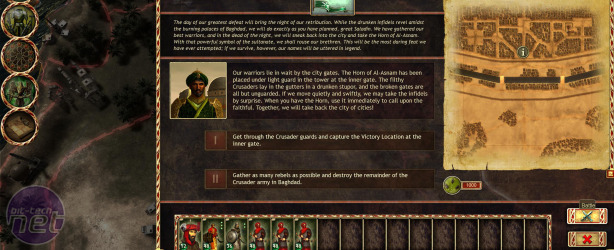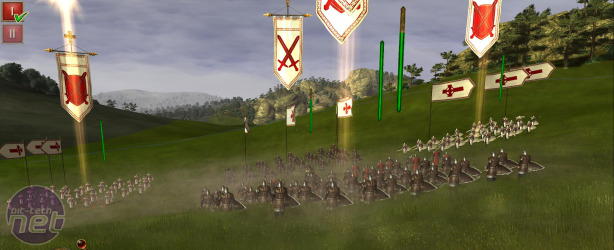
Lionheart Review
Away from the politicking and mission selection, things are a bit simpler and Lionheart does little to stand out from the rest of the strategy crowd. You’ve got the same basic controls and array of forces as in any other medieval strategy game and, while the battlefields are vast, they aren’t grand enough to shame any other modern RTS. Lionheart’s battles are so similar to most other RTS’ that it can feel like you’re just playing a slightly uglier version of a better game.Terrain, stamina and morale are the main three factors to consider when planning your strategy, as each unit does well only under certain condition. You can pick your forces before each battle, buying new units and letting others heal, but it’s not just as simple as buying the most powerful knights you can afford – you need to consider the environment. Archers can be instrumental in city battles, for example, where open streets deprive enemies of cover and arrows can reach into surrounding alleys.
Most of these features are pretty par for the genre nowadays, but there are a few idiosyncrasies that make Lionheart notable, mainly involving the blend of RPG and RTS elements. Units and heroes can level up through winning battles, but can also gain specific traits through certain activities, such as ruthlessly running down routed enemies.
Heroes can make use of holy relics and potions too, with Lionheart making the dubious claim that such items have ‘proven miraculous powers’. In the game, maybe. Either way, if you don’t fancy decking your soldiers out with bits of old bone then you can send relics back to the Pope, winning the favour of Men In Funny Hats.
Away from the singleplayer content, the multiplayer options are unfortunately limited to just simple skirmishes – either free-for-alls or domination battles involving a few capture points. The same limitations are imposed on the ‘Scenario’ mode too, which allows you to square off against bots and test certain units against each other. It’s something worth doing, as some unit descriptions can be a bit misleading – the Crusader’s Pilgrim unit, for example, is described as being made of untrained warriors with crude weapons and armour. Personally, we found them quite effective.
Lionheart does well with it’s singleplayer campaign, working in a surprising breadth of mission types across both campaigns. Night missions are especially interesting on harder difficulties, as the time of day and weather conditions can dramatically tip the odds one way or another.
The multiplayer offering however, is a lot less robust. With just two different game modes to play with, things can quickly start to feel familiar. It’s disappointing to see Lionheart, a game which otherwise veers away from simple ‘Conquer X’
 objectives, reduce it’s multiplayer to such basic concepts. Surely there’s room for multiplayer rescue or escort missions? The levels are certainly large enough – which also become a problem unless you have lots of soldiers to keep you busy. Waiting for a lone archer squad to move into position can be a bit tedious even with the game speed ramped up to full.
objectives, reduce it’s multiplayer to such basic concepts. Surely there’s room for multiplayer rescue or escort missions? The levels are certainly large enough – which also become a problem unless you have lots of soldiers to keep you busy. Waiting for a lone archer squad to move into position can be a bit tedious even with the game speed ramped up to full. Despite the weaknesses of the multiplayer content though – and a few interface niggles, like the inability to save mid-mission – Lionheart’s singleplayer portion left us with a pleasant aftertaste. The end result is undoubtedly a mixed bag, but varied missions and an absorbing RPG system easily balance out a bland presentation and occasionally faltering pace. Lionheart isn’t destined to be crowned the king of strategy games, but it’s a worthy title to occupy yourself with while you wait for that to show up.
Score Guide

MSI MPG Velox 100R Chassis Review
October 14 2021 | 15:04











Want to comment? Please log in.